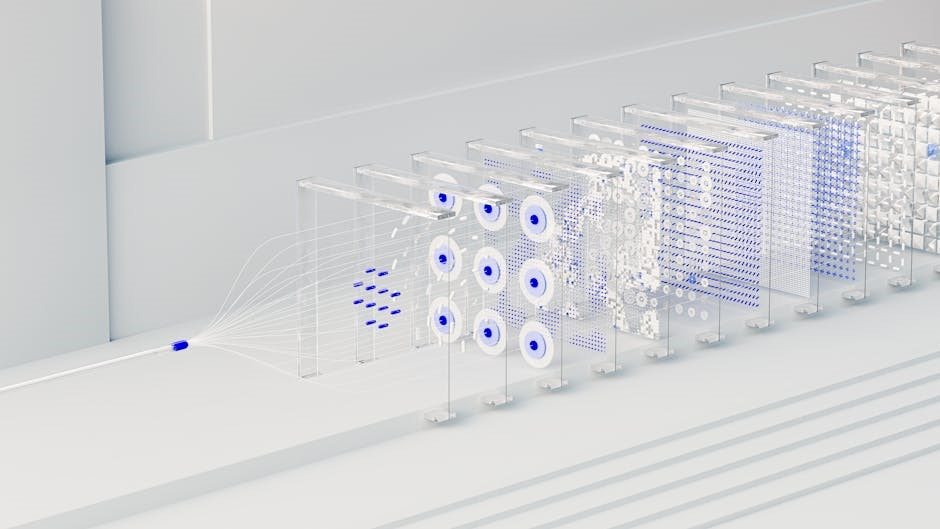
system verilog tutorial
SystemVerilog is a powerful hardware description and verification language (HDVL) extending Verilog-2001․ It enhances design and verification productivity with advanced features like OOP‚ assertions‚ and interfaces․
1․1 Overview of SystemVerilog
SystemVerilog is a third-generation hardware description and verification language (HDVL) that extends Verilog-2001․ It is widely used in semiconductor design for modeling‚ simulating‚ and verifying digital systems․ The language combines design and verification capabilities‚ making it a comprehensive tool for both hardware designers and verification engineers․ SystemVerilog introduces advanced features like object-oriented programming (OOP)‚ assertions‚ and interfaces‚ enabling more efficient and reusable code․ It supports modular design through modules‚ ports‚ and hierarchical structures․ Additionally‚ it integrates seamlessly with tools like ModelSim for simulation and debugging‚ making it a cornerstone of modern digital design workflows․
1․2 History and Evolution of SystemVerilog
SystemVerilog‚ the third generation of the Verilog standard‚ was developed to address the growing complexity of digital design and verification․ It evolved from Verilog-2001‚ incorporating new features like object-oriented programming‚ assertions‚ and direct programming interfaces (DPI)․ Standardized in 2005‚ SystemVerilog became a cornerstone for hardware design and verification‚ enabling more efficient and reusable code․ Its evolution reflects the semiconductor industry’s need for advanced tools to handle complex projects‚ solidifying its role as a leading hardware description and verification language (HDVL)․
1․3 Key Features of SystemVerilog
SystemVerilog is a powerful hardware description and verification language (HDVL) offering advanced features for digital design․ It includes object-oriented programming (OOP) concepts like classes‚ inheritance‚ and polymorphism․ The language supports assertions for formal verification‚ enabling precise specification of design behavior․ Interfaces and clocking constructs simplify module communication․ Additionally‚ SystemVerilog introduces randomization and constraints for efficient testbench development․ Its direct programming interface (DPI) allows integration with C code‚ enhancing verification capabilities; These features make SystemVerilog a comprehensive tool for modern hardware design and verification workflows․

Basic Syntax and Structure
SystemVerilog’s syntax begins with modules and ports defining hardware structure․ It includes basic gates and net types for digital circuit design‚ with a clear hierarchical structure for organization․
2․1 Modules and Ports
In SystemVerilog‚ a module represents a hardware component‚ serving as the fundamental building block․ It encapsulates logic‚ interfaces‚ and connectivity․ Ports are the entry and exit points of a module‚ enabling communication with other components․
Ports are declared within the module’s interface and can be of type input‚ output‚ or inout․ They facilitate data flow between modules‚ allowing signals to be passed back and forth․ For example‚ a simple module might have input ports for control signals and output ports for data transmission․
Properly defining modules and ports is essential for designing scalable and reusable hardware systems in SystemVerilog․
2․2 Basic Gates and Net Types
SystemVerilog supports basic gates like AND‚ OR‚ NOT‚ and NAND‚ enabling combinational logic design․ These gates are instantiated using predefined primitives․ Additionally‚ net types such as wire‚ reg‚ and tri are used to connect and store signals․ Wire represents physical connections‚ while reg holds procedural values․ Tri (three-state) nets allow for bus structures with high-impedance states․ Understanding these elements is foundational for constructing digital circuits and ensuring proper signal flow in SystemVerilog designs․
2․3 Hierarchical Structure
SystemVerilog supports a hierarchical design approach‚ allowing complex systems to be broken into smaller‚ manageable modules․ Each module represents a functional block‚ defined using the module and endmodule keywords․ Ports connect modules‚ enabling signal communication between hierarchies․ A top-level module encapsulates lower-level submodules‚ promoting modularity and reuse․ This structure enhances readability‚ scalability‚ and maintainability of large designs․ Hierarchical naming enables accessing signals across modules‚ while parameters allow customization․ This approach is essential for designing and verifying intricate digital systems effectively․
2․4 Boolean Equations and Operators
SystemVerilog provides a robust set of Boolean equations and operators for designing digital circuits․ Boolean equations are used to assign logical values to variables‚ while operators include logical (&&‚ ||‚ !)‚ bitwise (&‚ |‚ ^)‚ and reduction (&&‚ ||‚ ^) operations․ These operators enable complex logical expressions‚ simplifying the implementation of combinational and sequential logic․ Boolean equations are essential for modeling digital behavior‚ and operators enhance the expressiveness of the language‚ making it easier to design and verify digital circuits accurately․

Data Types in SystemVerilog
SystemVerilog introduces rich data types‚ including nets (wire‚ wand‚ wor) and variables (reg‚ integer‚ real)․ Arrays and bundles simplify data grouping‚ while enumerations (enum) enhance code readability and constraints․ Parameters and constants enable reusable designs․
3․1 Net and Variable Types
In SystemVerilog‚ net types (wire‚ wand‚ wor) represent physical connections‚ while variable types (reg‚ integer‚ real) store sequential data․ Nets model signal flow‚ whereas variables hold procedural values․ Reg is the most common variable type‚ used in procedural blocks․ Understanding these types is crucial for designing accurate digital circuits and testbenches‚ as they determine how data flows and is stored within a module․ Proper use ensures efficient and error-free hardware designs․
3․2 Arrays and Bundles
SystemVerilog introduces arrays and bundles to simplify data management․ Arrays allow grouping of multiple elements of the same type‚ such as wire‚ reg‚ or integer‚ enabling efficient manipulation․ Bundles enable combining variables into a single name for easier port connections and hierarchical referencing․ Arrays are declared using square brackets‚ while bundles use curly braces․ These constructs enhance readability and reduce code complexity‚ making designs more maintainable․ For example‚ an array of signals can be accessed by index‚ and bundles can streamline module interfaces without introducing new variables․
3․3 Enumerations
SystemVerilog introduces enumerations to enhance code readability and maintainability․ Enums allow users to define a set of named values‚ improving clarity in design and verification․ They are declared using the enum keyword and can be used with or without explicit values․ Enums are particularly useful for defining states in finite state machines or encoding logical conditions․ They can be synthesized and simulated‚ making them versatile for both design and testbench development․ By using enums‚ designers can create more intuitive and error-resistant code‚ ensuring better overall design quality and easier debugging․ Enums also support operations like assignment and comparison․
3․4 Parameters and Constants
Parameters in SystemVerilog are used to pass values into modules‚ enabling flexible and reusable designs․ They are defined using the parameter keyword and can be overridden during instantiation․ Constants‚ defined with localparam or parameter‚ hold fixed values throughout the design‚ improving code readability․ Both parameters and constants are evaluated at compile time‚ ensuring efficient synthesis and simulation․ They are essential for managing design configurations‚ such as timing parameters or initialization values‚ without altering the underlying logic․ Proper use of parameters and constants enhances modularity and simplifies design maintenance․ They are widely used in testbenches and RTL code for consistent configurations․

Procedural Statements
Procedural statements in SystemVerilog control sequential execution‚ enabling conditional behavior and timing․ They include always blocks‚ initial blocks‚ tasks‚ functions‚ and timing controls for simulation accuracy and design flexibility․
4․1 Procedural Blocks and Processes
Procedural blocks and processes are fundamental to controlling sequential execution in SystemVerilog․ The always and initial keywords define blocks that execute during simulation․ always blocks are sensitive to signal changes‚ while initial blocks execute once at the start․ These blocks are essential for modeling combinational logic‚ sequential circuits‚ and testbench components․ Processes can be nested for complex behaviors‚ enabling hierarchical design and verification․ Proper use of these constructs ensures accurate timing and functionality in digital designs‚ making them a cornerstone of SystemVerilog’s procedural capabilities․
4․2 Tasks and Functions
Tasks and functions in SystemVerilog are reusable subroutines that simplify code organization and reduce redundancy․ Tasks are used for complex operations‚ allowing multiple output arguments and execution over time․ They are often called from always or initial blocks for sequential behavior․ Functions‚ however‚ return a single value and execute in one step‚ making them ideal for combinational logic․ Both can take inputs‚ parameters‚ and variables‚ enhancing modularity․ Tasks and functions are widely used in testbenches for verification‚ enabling reusable and maintainable code․ Proper usage improves readability and promotes efficient design practices in SystemVerilog projects․
4․3 Timing and Delays
SystemVerilog provides robust constructs for managing timing and delays‚ essential for accurate digital design simulation․ Delays can be specified using the # symbol‚ allowing precise timing control for signal propagation․ inertial and transport delays model signal propagation accurately․ Timing in always blocks ensures sequential behavior‚ while event controls synchronize actions during simulation․ These features are critical for designing and verifying complex circuits‚ enabling realistic timing simulations; Proper use of delays ensures functional and temporal accuracy in SystemVerilog models and testbenches․
Object-Oriented Programming (OOP) Concepts
SystemVerilog introduces OOP concepts like classes and objects‚ enabling encapsulation‚ inheritance‚ and polymorphism․ These features enhance code reuse‚ abstraction‚ and modularity‚ making verification methodologies more efficient․
5․1 Classes and Objects
In SystemVerilog‚ classes and objects are fundamental to object-oriented programming (OOP)․ A class defines a blueprint for creating objects‚ which encapsulate data (properties) and behavior (methods)․ Classes enable code reuse‚ abstraction‚ and modularity‚ making testbench development more efficient․ They support inheritance and polymorphism‚ allowing for hierarchical and flexible designs․ Additionally‚ classes can include constraints for randomization‚ making them essential for verification methodologies like UVM․ This feature-rich approach simplifies complex hardware modeling and verification‚ ensuring scalability and maintainability in modern digital designs․
5․2 Inheritance and Polymorphism
In SystemVerilog‚ inheritance allows a derived class to inherit properties and methods from a base class‚ promoting code reuse and hierarchical design․ This OOP feature is particularly useful in testbench development‚ enabling the creation of specialized components from generic ones․
Polymorphism enables objects to take multiple forms‚ such as method overriding or overloading․ This flexibility is invaluable for verification‚ where objects must adapt to varying scenarios․ Combined‚ inheritance and polymorphism enhance modularity and scalability in complex hardware designs․
5․3 Randomization and Constraints
In SystemVerilog‚ randomization allows automatic generation of stimulus values for verification‚ reducing manual effort․ Constraints define valid ranges and relationships‚ ensuring stimuli meet design requirements․ This is crucial for coverage-driven verification‚ where scenarios must explore diverse conditions efficiently․
Randomization is enabled using keywords like rand and randc․ Constraints are applied using constraint blocks‚ enabling precise control over variable values․ Together‚ these features streamline testbench development and improve verification productivity‚ ensuring comprehensive design validation․

Interfaces and Clocking
SystemVerilog’s interface encapsulates communication protocols‚ while modport defines directional signals․ Clocking blocks synchronize timing‚ enabling precise control over signal propagation and timing checks‚ enhancing verification accuracy and design reuse;
6․1 Interface Syntax and Modport
In SystemVerilog‚ an interface defines a communication protocol‚ encapsulating signals and methods․ The modport keyword specifies signal directions‚ enabling reusable and abstract interface definitions․ Interfaces can include clocking blocks for synchronized timing‚ enhancing verification by grouping related signals and timing checks․ This feature improves readability and modularity in designs‚ allowing for easier integration of IP blocks and testbenches․ Proper use of interfaces and modports streamlines the design process‚ reducing errors and improving maintainability in complex digital systems․
6․2 Clocking and Synchronization
Clocking and synchronization in SystemVerilog are essential for managing timing within digital designs․ The language provides clocking blocks to define clock and signal timing‚ enhancing verification accuracy․ These blocks can be used within interfaces to group related signals and specify their timing behavior․ The `default` clocking allows setting a module-wide timing standard‚ simplifying design management․ Proper synchronization prevents race conditions and ensures signal integrity‚ especially in multi-clock or asynchronous systems․ These features are crucial for designing reliable and predictable digital circuits‚ avoiding timing-related issues that are challenging to identify and fix․

Assertions and Functional Coverage
SystemVerilog’s assertions and functional coverage enhance verification by enabling precise detection of design flaws․ They ensure comprehensive testing‚ improving reliability and reducing debugging efforts significantly․
7․1 Immediate and Concurrent Assertions
SystemVerilog provides immediate and concurrent assertions for precise verification․ Immediate assertions check conditions at a specific time‚ while concurrent assertions monitor conditions over a sequence of clock cycles․ These constructs enable robust validation of digital designs‚ ensuring functional correctness and reliability․ By embedding these assertions‚ engineers can detect flaws early‚ streamline debugging‚ and improve overall design quality․ This feature is essential for complex systems requiring rigorous testing and validation protocols․
7․2 Properties and Sequences
Properties and sequences are fundamental constructs in SystemVerilog for defining and verifying temporal behaviors․ Properties specify conditions that must hold true over time‚ enabling the creation of complex assertions․ Sequences‚ on the other hand‚ describe specific patterns of events or signal changes‚ allowing for detailed verification of design interactions․ Together‚ they enhance the flexibility and precision of temporal verification‚ ensuring that designs meet their functional requirements; These constructs are essential for building robust testbenches and ensuring the integrity of digital systems․
7․3 Coverage-Driven Verification
Coverage-driven verification ensures that all possible design scenarios are thoroughly tested by specifying constraints and tracking coverage metrics․ SystemVerilog’s advanced features enable the creation of comprehensive coverage models‚ allowing engineers to measure how extensively their testbench exercises the design․ By defining properties and sequences‚ users can generate random stimuli that meet these constraints‚ ensuring that all corner cases are explored․ This approach significantly improves verification efficiency and ensures design integrity by providing detailed insights into which parts of the design have been tested․ It is a critical methodology for achieving robust verification in complex digital systems․

Testbench Development
Testbench development in SystemVerilog involves creating reusable verification environments using UVM․ It ensures comprehensive testing of RTL code‚ improving design reliability and verification efficiency significantly․
8․1 RTL Code and Testbench Basics
RTL (Register-Transfer Level) code forms the core of digital designs‚ describing circuit behavior․ Testbenches are essential for verifying RTL functionality‚ using stimuli to simulate real-world scenarios․ They include modules‚ signals‚ and assertions to validate design outputs․ Basics involve writing test cases‚ initializing signals‚ and monitoring responses․ Proper testbench structure ensures thorough testing‚ catching design flaws early․ Effective testbenches accelerate verification‚ enhancing overall design reliability and reducing debugging time․
8․2 UVM (Universal Verification Methodology)
UVM (Universal Verification Methodology) is a standardized approach for verifying complex digital designs․ Built on SystemVerilog‚ it provides reusable libraries and methodologies for creating modular testbenches․ UVM enables scalable verification environments by separating test scenarios from design-specific details․ Key components include test cases‚ sequences‚ drivers‚ and monitors․ UVM automates stimulus generation‚ data collection‚ and result analysis‚ improving verification efficiency․ Its class-based structure allows for reusable verification IP‚ reducing development time․ UVM also supports advanced features like coverage collection and assertion checking‚ ensuring thorough design validation․
8․3 Building Verification Testbenches
Building verification testbenches is essential for validating digital designs․ Testbenches simulate real-world scenarios to ensure design functionality․ They consist of stimulus generation‚ monitoring‚ and verification components․ SystemVerilog enhances testbench development with features like interfaces‚ modports‚ and clocking․ Reusable testbench components‚ such as drivers and monitors‚ improve efficiency․ Advanced methodologies like UVM provide structured frameworks for building scalable testbenches․ Proper testbench design ensures comprehensive coverage‚ reducing design flaws․ By automating stimulus and result analysis‚ testbenches accelerate the verification process‚ ensuring high-quality design outcomes․

Direct Programming Interface (DPI)
SystemVerilog’s DPI enables interoperability between SystemVerilog and C code‚ allowing integration of external algorithms and enhancing design verification capabilities through direct function calls and data exchange․
9․1 DPI Basics and Applications
The Direct Programming Interface (DPI) in SystemVerilog allows seamless communication between SystemVerilog and external languages like C or C++․ This feature enables engineers to integrate custom algorithms‚ libraries‚ or software components directly into their hardware designs․ DPI fosters collaboration between hardware and software teams by enabling function calls and data exchange in both directions․ It is widely used in simulation-based verification‚ where external tools or algorithms can be leveraged to enhance testbench functionality․ DPI applications include hardware-software co-simulation‚ accelerating verification tasks‚ and integrating legacy code into modern designs․
9․2 SystemVerilog and C Interoperability
SystemVerilog and C interoperability is facilitated through DPI‚ enabling bi-directional communication between hardware and software; This allows engineers to call C functions from SystemVerilog and vice versa‚ enabling hardware-software co-simulation․ DPI enables the integration of complex algorithms written in C into SystemVerilog testbenches‚ enhancing verification capabilities․ Data types like integers and strings can be seamlessly passed between the languages․ This feature is particularly useful for accelerating verification tasks‚ integrating legacy C code‚ and creating hybrid models that combine hardware and software components‚ fostering a more collaborative design and verification process․

Advanced Topics
Advanced features include cross-coverage for measuring coverage combinations‚ Aspect-Oriented Programming (AOP) for modular concerns‚ and VMM to enhance verification methodologies‚ improving design and test efficiency․
10․1 Cross-Coverage and Advanced Features
Cross-coverage in SystemVerilog allows tracking combinations of coverage metrics‚ enhancing verification thoroughness․ Advanced features like the cross construct enable measuring interactions between different coverage points‚ ensuring comprehensive design validation․ These capabilities help in identifying complex scenarios and improving testbench effectiveness․ By leveraging these features‚ engineers can achieve higher coverage goals and ensure robust verification of digital systems․ This section explores how to implement cross-coverage and utilize advanced features for sophisticated verification methodologies․
10․2 Aspect-Oriented Programming (AOP)
Aspect-Oriented Programming (AOP) in SystemVerilog enables separation of concerns‚ allowing for modularization of cross-cutting functionalities․ This paradigm is particularly useful for inserting logging‚ timing checks‚ or security features without altering the main code․ AOP enhances code reusability and maintainability by encapsulating these aspects independently․ SystemVerilog supports AOP through specific constructs‚ making it easier to manage complex verification and design tasks․ By integrating AOP‚ engineers can create more modular‚ efficient‚ and maintainable testbenches and designs‚ ensuring better scalability and readability in large-scale projects․
10․3 VMM (Verification Methodology Manual)
VMM‚ or Verification Methodology Manual‚ is a comprehensive guide for advanced verification techniques in SystemVerilog․ It provides a structured approach to developing efficient testbenches‚ emphasizing reusability and modularity․ VMM integrates seamlessly with SystemVerilog’s object-oriented programming and assertion-based verification features․ It focuses on improving verification efficiency by standardizing methodologies and reducing the time spent on testbench development․ By adhering to VMM guidelines‚ engineers can create robust verification environments that align with industry best practices‚ ensuring high coverage and reliability in complex digital designs․

Simulation and Tools
EDA Playground and ModelSim are popular tools for simulating SystemVerilog designs․ They provide comprehensive environments for testing‚ debugging‚ and validating digital circuits with advanced features support․
11․1 Using EDA Playground for Simulation
EDA Playground is a web-based tool for simulating SystemVerilog designs․ It provides a user-friendly environment to write‚ simulate‚ and debug code․ The platform supports SystemVerilog‚ Verilog‚ and VHDL‚ allowing designers to test their logic and view results in real-time․ With waveform displays and debugging features‚ EDA Playground simplifies the verification process․ It eliminates the need for local software installation‚ enabling access from any browser․ This tool is particularly beneficial for beginners and experienced engineers alike‚ offering a seamless experience for designing and validating complex digital circuits․
11․2 ModelSim and Finite State Machines
ModelSim is a popular simulator for SystemVerilog designs‚ enabling the creation and testing of finite state machines (FSMs)․ FSMs are essential in digital design‚ managing sequential logic through states․ ModelSim allows users to simulate FSM behavior‚ view waveforms‚ and debug designs․ By integrating SystemVerilog features‚ it supports complex verification methodologies․ Engineers can visualize state transitions‚ ensuring correct functionality․ This combination of ModelSim and FSM design streamlines the development process‚ facilitating accurate and efficient testing of digital systems․
Resources and Learning
Explore SystemVerilog through tutorials‚ books‚ and online courses․ Resources include “A SystemVerilog Primer” by J․ Bhasker and GitHub repositories offering practical examples and verification methodologies․
12․1 Recommended Books and Tutorials
For mastering SystemVerilog‚ “A SystemVerilog Primer” by J․ Bhasker is highly recommended‚ offering practical insights․ Online tutorials and video courses cover syntax‚ OOP concepts‚ and verification․ GitHub repositories provide examples and verification methodologies․ Tutorials on EDA Playground demonstrate modules‚ interfaces‚ and assertions․ UVM methodologies and testbench development are also well-documented․ Community forums and playlists offer additional learning resources‚ ensuring comprehensive coverage for both beginners and experienced engineers․
12․2 Online Courses and Communities
Online courses on Udemy‚ Coursera‚ and edX offer structured learning paths for SystemVerilog‚ covering OOP‚ assertions‚ and verification․ Forums like Stack Overflow and Reddit host active discussions․ GitHub repositories provide open-source examples․ LinkedIn groups and professional communities share insights․ Webinars and workshops by industry experts enhance knowledge․ These resources foster collaboration and continuous learning‚ helping engineers master SystemVerilog efficiently․
SystemVerilog is a powerful HDVL that revolutionizes digital design and verification․ Its comprehensive features‚ from OOP to assertions‚ enable efficient and robust hardware development․ This tutorial has covered key concepts‚ practical examples‚ and advanced methodologies‚ providing a solid foundation for engineers․ By mastering SystemVerilog‚ designers and verifiers can tackle complex projects with confidence․ Continuous learning through resources like tutorials‚ courses‚ and communities ensures staying updated with industry standards and best practices‚ driving innovation in the semiconductor and FPGA domains․